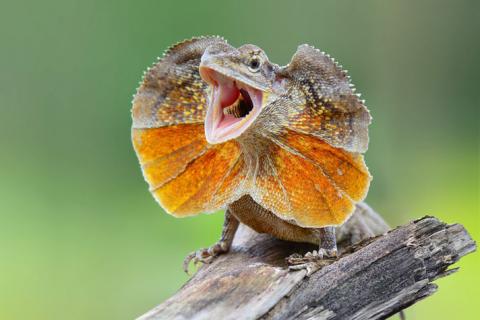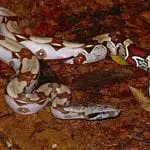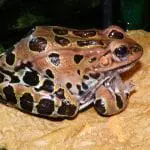If you have ever seen the first Jurassic Park film, you would know how iconic yet scary that frilled-neck dinosaur is. Once that skin on its neck frilled up, you knew that things were about to go bad for Wayne Knight in his final scene in the movie. That was one of the more iconic scenes during the 90s, but it kind of gave a bad reputation to one of the most popular lizards in the exotic pet trade today.
The Frilled-Neck Lizard is one of the most unique and physically appealing lizards in the world today. It carries that same iconic frilled neck that you would nonetheless associate with that dinosaur you saw in Jurassic Park. However, it often gets a bad reputation because of its appearance. You have to know more about the Frilled-Neck Lizard to understand that it is anything but vicious and aggressive. And understanding more about this reptile goes a long way when it comes to caring for it the right way.
Overview
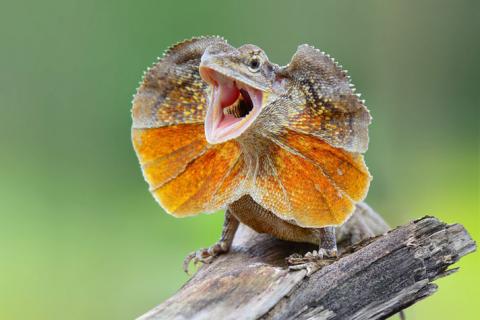
The Frilled-Neck Lizard is a reptile that is native to the continent of Australia and in certain portions of New Guinea as well. They mostly inhabit the coastal areas of Australia and the southern portions of New Guinea. These lizards prefer places that have a humid climate and those with a lot of interlocking trees because of their nature as arboreal animals that spend a lot of time on branches rather than on the ground, although they may also come down from time to time when they are hunting for food.
While the Frilled-Neck Lizard looks a lot like the Dilophosaurus, which was made famous by Jurassic Park (which in turn helped make the Frilled-Neck Lizard popular), they are not as aggressive. This allows the Frilled-Neck Lizard to be an ideal pet to have for both novices and intermediate reptile owners as they are not too difficult to handle and take care of. A lot of different owners even regard them as some of the more fascinating yet uncommon types of pet reptiles to have at home.
The Frilled-Neck Lizard gets to live for about 10 years at a maximum as they are not as long-lived as some other pet reptiles are. However, you should expect that females are going to live shorter lives than males because of how the stress of laying eggs can put a toll on their health.
Physical Description
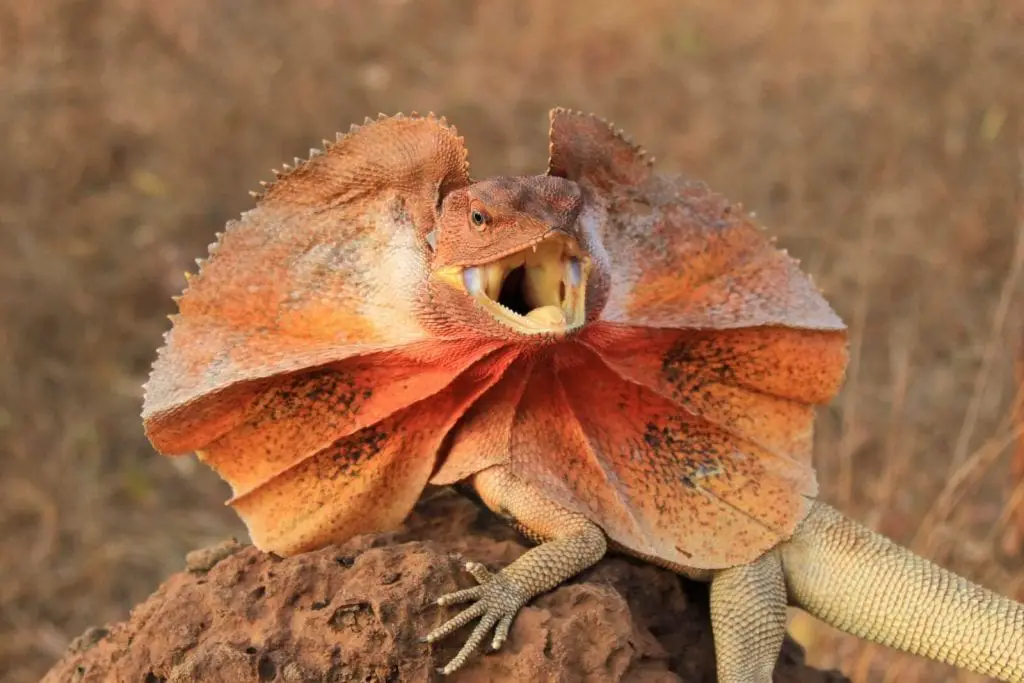
The Frilled-Neck Lizard is a moderately-sized type of reptile that is usually somewhere between 2 and 3 feet in terms of its length. Males are generally bigger and longer than the females as the latter are usually about only two-thirds of the male’s average length. Other than that, the males and females usually have the same appearance.
Frilled-Neck Lizards are said to come in all sorts of colors, but, as far as documentation is concerned, it only comes in one species that may vary in color. These lizards are usually yellowish in color but may also be close to orange in some cases. However, this is not always the case as there are some Frilled-Neck Lizard that varies in color depending on where they come from and on their ancestry. The region and the type of environment the reptile comes from may play a role in its color because these lizards should have a color scheme that allows them to blend with their surroundings. The Frilled-Neck Lizard’s body is usually darker than its frill.
Speaking of its frill, what makes the Frilled-Neck Lizard as popular as it is may actually that thin membrane of skin surrounding its neck. That membrane is popularly known as the frill, which rises or extends outwards to give the lizard its iconic look. The Frilled-Neck Lizard only extends its frill outwards when it feels threatened. This is its way of defending itself as the frills allow it to look larger and more intimidating than it actually is.
Food and Water
The Frilled-Neck Lizard is an omnivore but is closer to being a carnivorous reptile that can eat a variety of different animals that are small enough to fit its mouth. They may also eat vegetation because of their omnivorous tendencies. This reptile would rather focus on seeking out meat as its main food source rather than to look for fruits and vegetables, which they actually rarely eat.
When looking for meat, the Frilled-Neck Lizard usually feeds on insects and invertebrates as these are small enough for them to feed in abundance while providing them the necessary basic nutrients they need to survive. They like eating brown crickets, different varieties of worms, roaches, and locusts. The Frilled-Neck Lizard may also feed on rodents that are small enough for them to eat. They will even eat other lizards that are a lot smaller than they are.
A Frilled-Neck Lizard kept in captivity should be given a diet that is focused more on crickets, super worms, waxworms, and mealworms. You should dust the reptile’s food with a calcium and vitamin D3 supplement to make up for the high phosphorus content of insects and invertebrates. Gut-loading, the insects, can also be a good idea to provide the Frilled-Neck Lizard a more well-rounded and complete meal. Feeding the insects and invertebrates with dark leafy greens before introducing them to your Frilled-Neck Lizard is always a good idea.
And while the Frilled-Neck Lizard does not always eat fruits and vegetables, you should still introduce them to the reptile from time to time even though there is no guarantee that it will eat them. Papaya, bananas, berries, and cantaloupe are good fruits to give to your reptile. Meanwhile, for the veggie route, you can go for collard greens, carrots, sweet potatoes, green beans, and leafy greens. Again, there is no guarantee that the Frilled-Neck Lizard will eat fruits and vegetables, but it won’t hurt to introduce them to your reptile. And because these reptiles won’t always eat fruits and vegetables, it is always better to gut-load your lizard’s insects and invertebrate to provide the Frilled-Neck Lizard the vitamins and minerals it would miss if it continues to avoid eating fruits and vegetables.
For the Frilled-Neck Lizard’s water, always provide a large water dish in its enclosure so that it can take a drink whenever it feels the need to rehydrate. However, you should always replace the water to avoid illnesses brought about by contamination.
Habitat
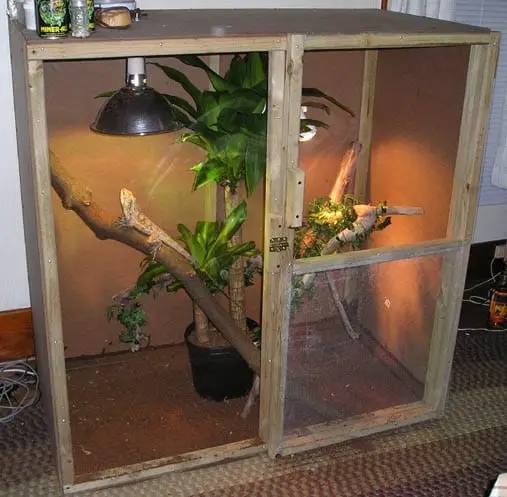
The Frilled-Neck Lizard should be placed in an enclosure that is large enough for it. Since this is an arboreal reptile, go for an enclosure that is vertically oriented rather than horizontally large to provide the lizard the climbing space it needs. You may want to go for a terrarium or an enclosure that is about 20 gallons tall and should be somewhere close to 6 feet tall.
Decorations are essential to the Frilled-Neck Lizard habitat because of its nature as an arboreal reptile. Place plants that are tall, large, and strong enough to handle the weight of the lizard whenever it is climbing on them. You can also place faux plants that may look and feel like plants if you want decorations that will last longer and require little to no maintenance on your part. Always place a lot of different branches to give the Frilled-Neck Lizard a wider variety of places to stay on.
The enclosure’s substrate can be anything that is able to retain humidity levels well. You can use coco fiber or cypress mulch in that regard.
Heating, Lighting, and Humidity
The Frilled-Neck Lizard comes from a warm and humid region. In that regard, it is always best to provide it with a habitat that fits its needs in terms of heating, lighting, and humidity levels to ensure that it will live its life happy, healthy, and thriving. Otherwise, you will most likely end up with a reptile that won’t last too long in its own home.
When you are looking to add some heat and light in the reptile’s enclosure, go for a heating bulb that can allow the ambient temperatures to be somewhere between 85 and 90 degrees Fahrenheit. At night, the ambient temperatures can drop to 75 degrees. However, the hottest portion of the enclosure should be the corner where you placed the heating lamp. Temperatures in this basking corner should be at most 115 degrees. For heating and lighting, an incandescent lamp should do the trick. However, you should also add a UVB light to provide the Frilled-Neck Lizard the ultraviolet B it needs for vitamin D3 and calcium metabolism.
Humidity levels in the enclosure should be around 55% to 65% as the Frilled-Neck Lizard thrives in a humid environment. Always make sure that the substrate is damp and never get too dry so that the enclosure will stay humid. The best way to maintain humidity levels is to mist the enclosure regularly. However, placing a large water dish may also be good when it comes to keeping things humid enough for your Frilled-Neck Lizard.

